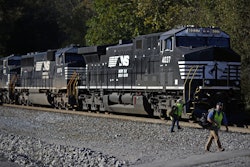
Integrating freight rail services into supply chains can yield significant benefits, including safety, efficiency and sustainability. Many shippers are already on board.
For some other shippers, shifting traffic to rail has not been practical due to the lack of visibility and accurate estimated times of arrival (ETAs), as well as the initial learning curve associated with converting from truck to rail.
Technology is rapidly knocking down these barriers.
During the past several years, advances in AI and machine learning have made it easier to ship by rail. Rail shippers are making major strides in many areas, including:
- rail shipment visibility,
- inbound empty equipment visibility,
- shipment booking,
- rate and route information,
- shipment ETAs, and
- demurrage management.
Technology advances are helping shippers who load/unload freight cars provided by railroads or others, as well as shippers who own or lease their own equipment.
Many shippers who don’t have their own rail car fleets are among those whose shipments move mostly or entirely by truck. These are the shippers who can often achieve the greatest supply chain benefits by converting a significant percentage of their shipments to rail. Even better, that transition can be gradual and manageable.
Each shipper’s circumstances are unique, and there are specific ways that technology can be adapted which are appropriate to specific situations. Following are some of the key opportunities where technology can improve or help initiate rail logistics.
Shipment Visibility: Some shippers have struggled with “black holes” where visibility is concerned, but advanced technology has cast a bright light on shipments. Though rail equipment location and status are reported in near real-time, not all shippers receive tracing across multiple railroads from one source. This, along with recent data science improvements in AI, brings shippers more accurate ETA predictions and actionable insights. With the right provider, shippers can now easily develop dashboards that produce continuous and accurate rail shipment status and reliable exception management information similar to what many shippers already use to track highway shipments.
These technologies are designed to do more than just provide rail shipment information. They can also be integrated into warehouse and production management systems to generate dynamic planning for optimized end-to-end supply chain operations. At the ultimate destination, this translates into improved customer satisfaction and loyalty.
Inbound Empty Equipment Visibility: Warehouse and production operations require a predictable and reliable supply of empty inbound transportation equipment. When rail cars don’t show up on time, or arrive in unmanageable quantities, plans for labor force size, floor space utilization and process flow can be thrown into severe disruption. These problems are significant for any shipper, but even more so for shippers of perishable products and fast-moving consumer goods.
Until recently, inaccurate inbound equipment forecasts have kept many shippers from making greater use of rail. Now, historic data can be married with real-time waybill and real-world information about service days, terminal capacity and more. What was an unmanageable glut of data can now be processed and presented as single-source insights. Coupled with AI and machine learning, shippers can leverage much more accurate predictions for the arrival of empty equipment at shipping locations.
Shipment Booking: What used to be a daunting task no longer needs to be. Preparing the basic rail shipping document—a Bill of Lading—requires detailed and accurate information to avoid rejections, misrouting or inaccurate billing. Mistakes as simple as misspelling the shipment destination can cause significant delays.
Electronic Bills of Lading (eBOL) have evolved to make mistakes virtually impossible. By instantly drawing accurate data from available rail industry sources. Plus, during manual entry, eBOL systems can offer correction and/or data updates as information is typed in.
With an eBOL system that uses live rail industry data, shippers no longer have to be rail experts and they can focus valuable time and resources on higher-value supply chain management needs.
Rate and Route Information: Planning the route, schedule and cost for a rail shipment requires information from disparate sources, making this a potential stumbling block for shippers. Now there are systems that will analyze all of this, instantly, for origin-destination (O-D) pairs. Seeing GIS-validated routing information on a map along with comparative rate, mileage and transit times, greatly simplifies what has been largely a manual task for many shippers.
Just as GIS opens new driving options on the highway, these systems can present new rail shipment routing options that might not have been previously considered. Automated rail rate and route information is one of the most recent advancements to become available and these capabilities are rapidly evolving.
Shipment ETAs: Another historic challenge for rail shippers has been the lack of reliable ETA information. Solutions are now available for many types of shipments. Look for automated ETA systems that account for the variety of possible operating conditions— including service availability, differences in train types, consistent delay trends and more.
With this new tool, supply chain managers can plan facility operations, manage inventory or inform customers. Using AI and machine learning, shippers can train ETA models for specific O-D pairs and deliver an ETA that accounts for complex operating practices.
Demurrage Management: Rail shippers can incur demurrage fees when cars are held in yards and loading facilities beyond the allowed number of free days. Free days are determined based on railroad-provided rules for specific locations and circumstances. With new yard-specific dashboards and alerting, shippers can identify demurrage situations at a glance and act before charges occur. New demurrage management systems offer benefits that include automatic demurrage estimates; enhanced yard visibility; management of differing rules at multiple locations; dwell and cycle time trends; and improved inbound car visibility to prioritize cars for loading/unloading.
These and other technology tools give shippers new ways to gather, analyze, and understand the massive flow of data resulting from rail logistics. Having all this available in dashboards which are updated in real time can open new insights that will improve the efficiency of existing rail operations and create new opportunities to improve safety, save costs, reduce carbon emissions and keep customer satisfaction high.
How can you determine if rail has new potential to improve your supply chain? Find a partner who can analyze your existing modal choices and develop manageable steps to convert shipments to rail where appropriate.


![Pros To Know 2026 [color]](https://img.sdcexec.com/mindful/acbm/workspaces/default/uploads/2025/08/prostoknow-2026-color.mduFvhpgMk.png?auto=format%2Ccompress&bg=fff&fill-color=fff&fit=fill&h=100&q=70&w=100)







![Pros To Know 2026 [color]](https://img.sdcexec.com/mindful/acbm/workspaces/default/uploads/2025/08/prostoknow-2026-color.mduFvhpgMk.png?ar=16%3A9&auto=format%2Ccompress&bg=fff&fill-color=fff&fit=fill&h=135&q=70&w=240)









